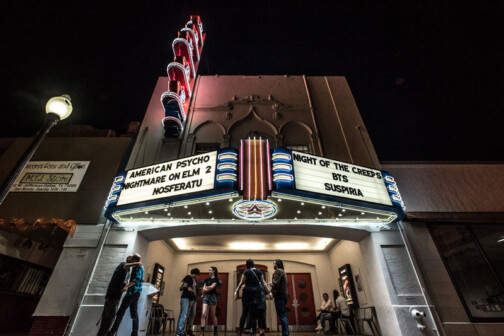SALLAD is Tramaine Townsend’s interpretation of Dallas. The film, made in collaboration with luxury watch company JBW, highlights Black Dallas. It features jovial shots of Black skaters in flux at the Dallas Skate Fair, the Xplosive Grenades Step Team in majestic formation at Arts Mission Oak Cliff, and singer Mattie Calloway in subdued technicolor lights.
Hance Taplin, then-creative director of JBW and founder of streetwear brand By Way of Dallas, approached Townsend with the idea to work on a project. For years, the two creative professionals kept up with each others’ work. The project afforded them an opportunity to do something as a collective. After the pair had an initial conversation about the project, Taplin connected with JBW and returned to Townsend with the idea of a film.
In the past, Townsend worked with Amir Meghani, CEO of JBW, on a film. SALLAD marks the second collaboration between the two. The director knew of Meghani and Jai Midget, the film’s producer and wardrobe stylist, through the city’s creative and social communities. He describes the partnership as a “natural fit for all of us to be working together to make something beautiful.”
Filmed in secret throughout Dallas, the film includes appearances from musical duo The Bros Fresh; musician Angel White; dancers Sierra Noelle Jones, Alexandra Newkirk, and Bianca Melidor; and several Black creatives.
On March 9, the film premiered at an invite-only Kessler Theatre screening. The screening was followed by a panel discussion, where the JBW team of Townsend, Taplin, Meghani, and Midget answered questions from the mixed audience of artists and commerce professionals. Since then, the film has screened at Soho House in Austin for the SXSW Film Festival and last Friday at Tractorbeam.
Townsend spoke to D Magazine about the origins of SALLAD, the film’s locations, and what he hopes people take away from the film.
The interview has been edited for clarity.
Could you tell me about the film’s origins?
A few years ago, I was with a friend of mine, Ruben Burgess Jr. I told him about my want to start a publication that would bring together the creative community in Dallas and highlight them in different ways. I didn’t know how to start it, but I knew wanted to call it “Sallad.” It’s a combination of ingredients put together for a bigger, broader excellence.
What led you to keep SALLAD a secret?
I wanted to keep it a secret because I did not want anyone to know or figure out the name of the film. I wanted to keep the name of it very tight. [JBW] kind of fought a little bit back and forth, but they trusted me enough do that. I’m glad that we did. For it to be such a bigger surprise to people, you know, was the real feeling and emotion that I wanted to get from people.
The film displays Dallas in a multitude of different ways. There is Fair Park. There is the historic church. There is a scene at the skating rink. A few of locations felt very special to me, especially the nuanced and complicated relationship Black Dallas has to Fair Park. I’m curious if there was a historical or cultural element to the locations used?
It was deeper in a cultural sense. We knew we wanted to go into the Hall of State. I have lived in Dallas for many years and never been in there. Whenever I was able to go in there and see, I was able to get an education that was way deeper that resonated with the film and the people that I wanted to be a part of that. Same for the Butterly museum. I don’t think a lot of people in Dallas, beside going to the Fair, know about these spaces.
Originally, we wanted to film [the step sequence] at the Bandshell in Fair Park. We felt the sounds and noises they would make would resonate and echo so loudly. I knew I wanted a place like that, that just really took in every hit that happen. Due to budgetary restrains, we were [not] able to get it. But we found Arts Mission Oak Cliff to do that shot there.
As a kid, I loved skating. I thought it was the greatest thing ever. I wanted that to be included in the film because it is such a celebration of things that are happening in one place. The music is always right. You are always in movement. You can keep on skating around. One thing you never have to worry about anything getting too out of control because everyone is here to skate and they encourage everyone to do the same thing.

The roller skating part is called Jubilee. I knew it had to be some type of celebratory moment between all Black people. It had to be powerful. It had to be intentional. We asked people if they wanted to be a part of it. It was well received between everyone we talk to. We filmed from 10 p.m. to 6 a.m. without interrupting what [they had] going on.
Let’s touch on one of the film’s parallels. At the end of the film’s opening sequence is a shot of a young Black boy’s eyes. In the last shot of the film, the young Black boy stands in his glory while an elongated pink durag flows in the background.
That was one of the shots that I knew had to be the most powerful. After all the stuff that you have seen before in the film, that is the one last moment that starts with a child. The one that has lived through this lifestyle where he see heroes and superheroes throughout [the film.] When I was younger, you grew with Superman and Batman, predominantly White superheroes. Now, he sees a superhero where you can be Black and proud of it now more than ever. By showing the durag, which is becoming more and more of a symbol of freedom and the Black experience, I wanted that to resonate with this child and any child to see that one last moment and be proud of who they are. The pink part of that is definitely where that child is figuring themselves out. They are going to take that time, but they are proud of themselves right now.
What are you wanting viewers to take away from SALLAD?
More than anything, I want Black people to see this film. I want them to really see themselves within this. I want them to feel like they can be proud and there is more than just everything that is going on with us. And how we can celebrate each other in different ways and facets. Slow down when we need to. Be present when we have to be. We should always be recognizing our past while creating and building for our futures.
Get the FrontRow Newsletter
Author





